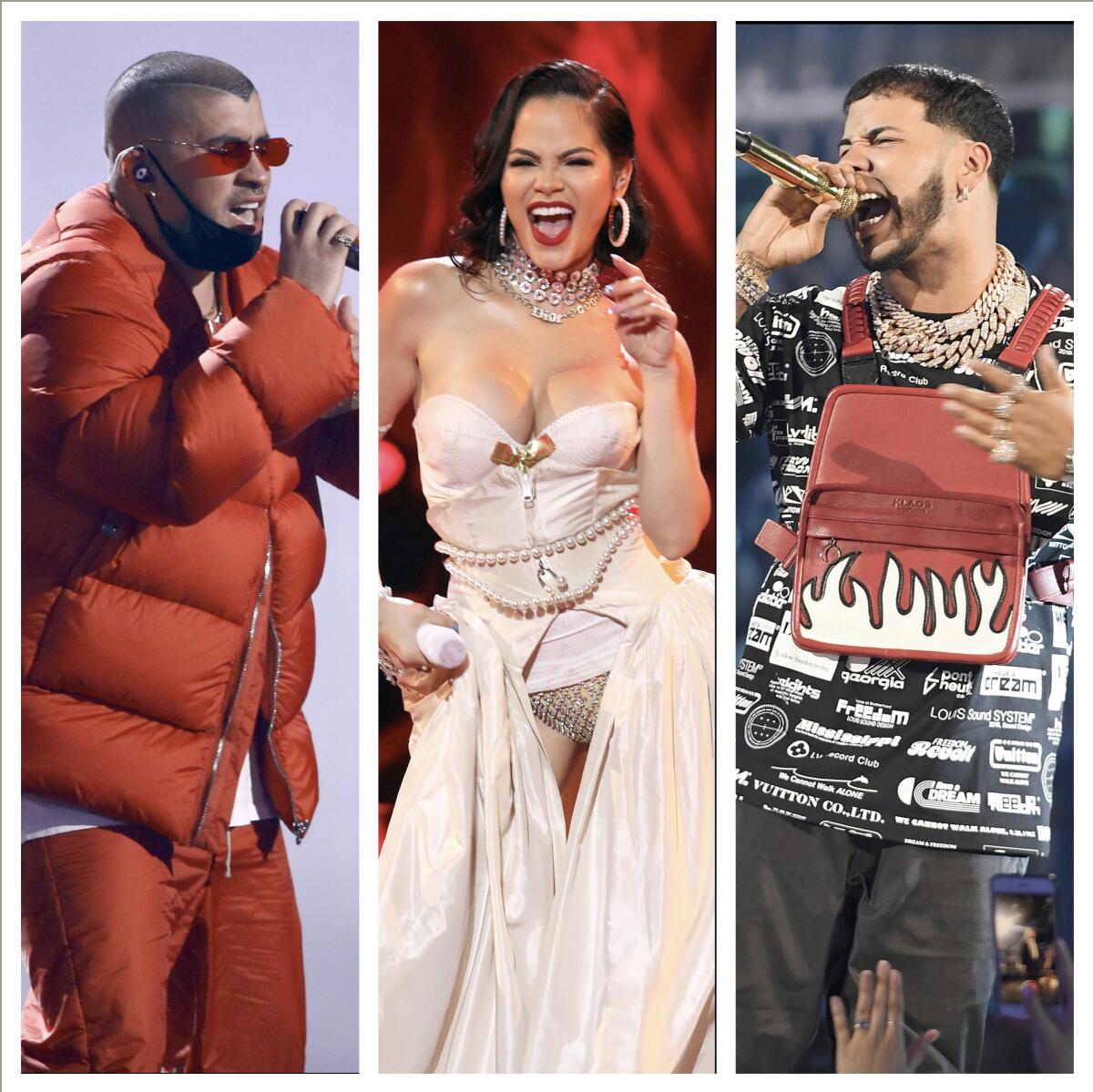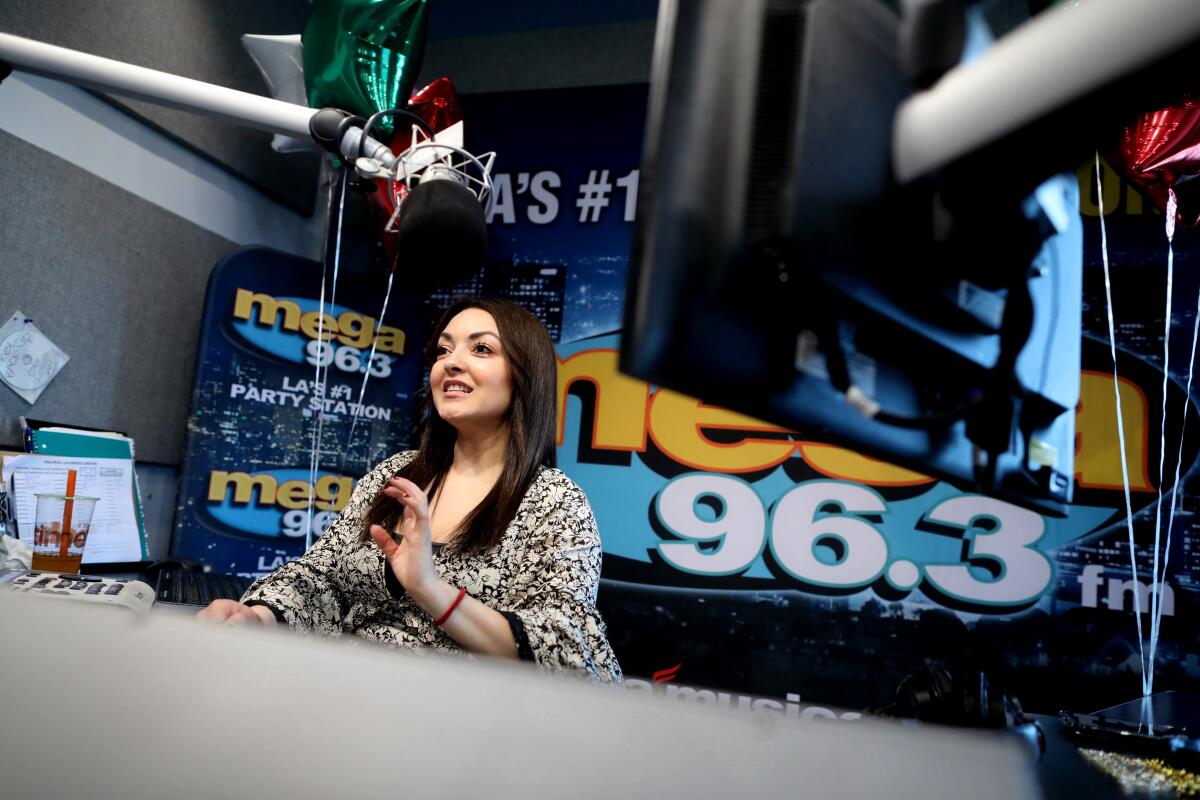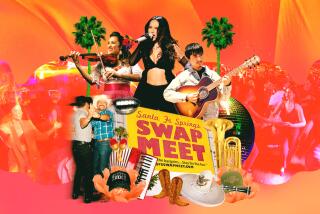Two L.A. radio stations, blasting reggaeton, wage a fierce battle for a growing young audience

Bridgett Diaz is excited for this weekend’s Calibash, the superstar-jammed annual concert put on by local radio station KXOL-FM, better known as Mega 96.3. Diaz was picking up tickets for the sold-out Staples Center concert at the station’s bustling lobby Wednesday, reminiscing about attending Calibash in 2018.
“Bad Bunny opened that show, and now he’s headlining,” Diaz said with wonderment. “It’s really amazing. The crowd is so energetic. And I’ve gone to a lot of concerts.”
For years, Mega 96.3-FM has enjoyed a perch on the local market as the only full-time home for reggaeton on L.A. radio. The station has relied on loyal listeners such as Diaz, a 34-year-old resident of West Covina, to build its brand. A daughter of immigrants, Diaz didn’t grow up speaking perfect Spanish but feels comfortable in the two cultures. She started listening to Mega about four years ago, when she “wanted to be in my Spanish vibes.”

Mega plays a youthful mix of reggaeton, bachata and bass-driven Latin pop. More pointedly, its on-air hosts mix English and Spanish in their banter, in a way that may sound unwieldy to the unfamiliar ear but easily sounds like the vernacular spoken in many L.A. homes. Diaz, who works for a mobile phone company, said the Mega hosts’ Spanglish “feels comfortable, more welcoming.”
Since 2005, long before the rest of the world wised up to the force of commercial “Latin urban” or “Latin trap” (terms that all ultimately serve as euphemisms for reggaeton in its multiple iterations), Mega has owned this crucially relevant space on L.A.’s airwaves, unchallenged.
But that is changing. Last July, a new player showed up: The former Spanish pop station KXOS-FM (93.9) switched to a bilingual Latin urban format, similar to Mega, and called itself “Cali 93.9.”
Now, there is a ratings war underway. The battle is between a seasoned station from a legacy terrestrial radio family and an upstart rival that in less than a year made a symbolic move onto Mega’s turf by poaching an on-air talent. Mega is already feeling the impact. Its ratings in the second half of 2019 dipped, while newcomer Cali got close to nipping at its heels, according to Nielsen.
Room for two in L.A.
The Calibash concert series, for now, is Mega’s bulwark, a live-event brand that has become an L.A. staple, with cameos in past years from top-tier mainstream figures including Cardi B and Justin Bieber.
Some 18,000 people are expected to show up each night this weekend to watch, among others, Bad Bunny, the scratchy-voiced Puerto Rican heartthrob who just three years ago memorably opened Calibash as an up-and-coming artist. The bill is shared with Spain’s Rosalía, and reggaeton hitmakers Sech, Anuel AA (spoken as “Doble A”) and Karol G from Colombia, whose collaboration with Nicki Minaj, “Tusa,” is in heavy rotation. Plus, there’s an added element of romance in the bill, as Karol G and Anuel AA are a known item.
Mega’s home offices are in a Midcentury tower on Wilshire Boulevard off the Miracle Mile. The station belongs to SBS Radio, or the Spanish Broadcasting System, a Spanish-language media company that grew with radio clan the Alarcón family, in New Jersey. SBS Radio also operates La Raza-FM (97.9), which programs a Mexican regional format.
Alessandra Alarcón, SBS’s L.A.-based chief of entertainment, is the granddaughter of SBS founder Raul Alarcón. She studied at Pepperdine and worked her way through sales at SBS before taking the helm of the Calibash concert four years ago. She promptly expanded it to two nights and then added a stand for the bill in Las Vegas, which will take place Jan. 25 and feature stars Daddy Yankee and Natti Natasha. When asked about Cali 93.9, Alarcón said the new arrival is a sign of validation for her team’s efforts.
“That means we’re doing our job. Imitation is the sincerest form of flattery,” Alarcón said, as staffers busied about Mega’s studios. “The demand is super high, and it’s helped that the genre is blowing up right now.”
When Cali 93.9 arrived, it wasn’t lost on industry observers that the new rival station’s name echoed the name of Calibash, the concert event by established rival Mega. The old KXOS call letters were switched to KLLI.
Ever since, the upstart challenger, owned by Meruelo Media, which also owns KPWR-FM Power 106, has been gnawing at Mega’s hold on the city’s young reggaeton fanbase. Last September, Cali 93.9 hired away Mega top on-air host, Eddie One. Since Cali’s arrival, Mega has dropped from 11th place in local market share to 20th place overall, according to Nielsen. Meanwhile, Cali finished December in 24th place — just six months after launching.
“It’s always competition, but at the same time, it’s a confirmation,” said Mega midday host Sandra Peña. “We’ve been doing this for so many years, it took fifteen years of the existence of Mega for someone to be, like, ‘Wow, we should make a station to embrace this format.’ ”
Leila Cobo, vice president of Latin music at Billboard, said there is room for more than one Latin urban radio station in a city as big as Los Angeles, although that idea may have sounded counterintuitive just two decades ago. Formats highlighting “tropical rhythms” have historically been more prevalent in cities such as New York or Miami, whereas in Los Angeles, Spanish-language radio has been led by Mexican regional genres “simply because of the population there,” Cobo said.
But after years of multiplying signals that reggaeton and Latin pop were basically merging — crooner Luis Fonsi collaborating with reggaeton royalty Daddy Yankee for 2017’s “Despacito” is now considered a watershed moment — L.A. is asserting itself as a town that can do both.

“This isn’t new,” Cobo said. “Calibash has been successful for many years.” The vibe, she said, mirrors the fact that “urban music completely dominates commercial Latin music in the United States, and not just in the United States. Everywhere.”
At Cali 93.9, team members said they were just getting started. Eddie One now anchors the afternoon show, the same slot he held at Mega. Isabel Gonzalez, the station’s content and brand director, said Cali should be a welcome addition to the table. Its hosts also speak in a free-flowing mix of Spanish and English.
“It talks a lot about the way the music industry is evolving, how the Latino population on its own is evolving,” Gonzalez said.
But Cali has a stretch to go before it could seriously challenge Mega’s overall presence. For starters, it doesn’t have a decade-on concert series of which to boast.
At Mega, the team likes to think that Calibash has transformed into a bellwether of an artist’s trajectory towards stardom. “Just a few years ago, Bad Bunny and Ozuna were opening the show, with ten-minute sets,” Alarcón said. “Last year, Ozuna closed the show with a 45-minute set.”
Josh Kun, a USC communications professor and writer, described the two stations’ sound as a “kind of like a Dodgers bilingualism,” where non-Latinos who are native to the L.A. milieu inevitably absorb some words or phrases in Spanish, even without being fluent or even conversant. Popular music is often a driving force of the phenomenon. “It’s a new global pop thing, and these stations are a part of that,” Kun said.
“It’s like talking with someone you know”
“It’s 5 o’clock somewhere, so dale, dale, es hora feliz,” Peña said the other day on the air, telling her listeners, “so ‘go for it, go for it, it’s happy hour.’”
A minute or so later, the host said she was returning from vacation and a bit behind on her pop culture news: “It’s my first day back, estoy un poquito retrasada,” Peña said.
Inside Mega’s lobby, listener Diaz said that the hosts’ nimble language-mixing sounds a lot like people who grew up like her. “My mom is from Michoacán and my dad is from Durango … My mom didn’t want us to learn Spanish because back in the ’80s, that’s the way it was.”
The station’s use of Spanglish, Diaz added, is “like you’re talking with someone that you know.”
More to Read
The biggest entertainment stories
Get our big stories about Hollywood, film, television, music, arts, culture and more right in your inbox as soon as they publish.
You may occasionally receive promotional content from the Los Angeles Times.











